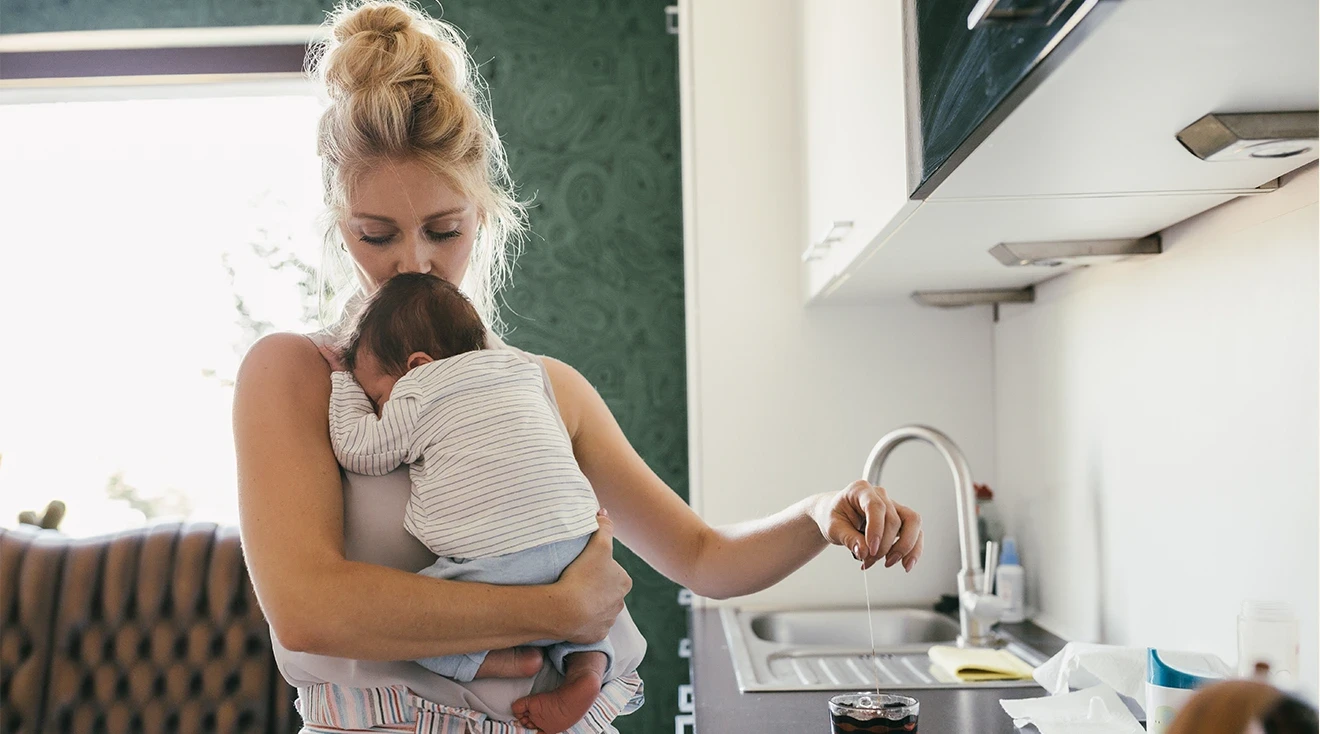This Is What Really Happens to Your Vagina After Birth
If you’re hoping to give birth vaginally, you might be wondering what’s in store for your vagina after birth. The vagina has a remarkable ability to stretch and accommodate the delivery of a full-term baby—but just how much does it stretch, exactly? Will you experience any tearing in the process? What might feel different about your vagina before and after birth? These are all natural questions to be asking. Below, we asked experts to break down the top changes to expect for your vagina after giving birth—as well as what you can do about them.
Childbirth is a major physical event, so it naturally takes a toll on your body. If you give birth vaginally, you can expect some vaginal changes that will take time to heal during postpartum recovery. Below, some of the short-term changes to expect for your vagina after giving birth.
Vaginal bleeding and discharge
Following birth, most women experience bleeding, called lochia that can last anywhere from two to eight weeks following delivery. “It’s the heaviest immediately after delivery and should get lighter in both color and amount as time goes by,” says Rebekah Mustaleski, CPM-TN, a certified professional midwife and compression director at Motif Medical. The bleeding should get lighter by the end of your first week postpartum. Over time, the bleeding will reduce to spotting. It may also stop for a few days and then come back, Mustaleski adds. “Until the bleeding has been gone for one full week, it could still come back again, which can be surprising, but it’s helpful to know that it’s a normal thing to have happen postpartum,” she explains. “It’s also good to know that the bleeding amount and color can change with activity.”
Soreness, bruising and swelling
It’s par for the course to experience soreness, bruising, swelling and increased sensitivity in your vagina after birth—after all, it just pushed out a baby! If you gave birth for the first time, experienced tearing or have vaginal sutures, you might also experience higher levels of discomfort. And unfortunately, the soreness isn’t limited to those who deliver vaginally. “Even if you gave birth by cesarean, vaginal exams can create swelling and tissue damage that will need time to heal,” Mustaleski says. Luckily, all of the swelling and discomfort in your vagina after giving birth should improve over time.
Vaginal itchiness and dryness
If you tore a lot during delivery or needed an episiotomy, you might have stitches down there following delivery. While these will heal and dissolve in about a week or so, you might experience some itchiness as they do. Another factor in vaginal itchiness after birth? Fluctuating hormones, which can dry out your skin. “Because your estrogen and progesterone levels drop during the postpartum [period], it’s also normal to have vaginal dryness—or even dryness all over your body,” Mustaleski says. Luckily, “once your cycles return, your normal vaginal lubrication should come back, too.”
You’ll be glad to know that most women don’t notice many long-term changes to their vagina after giving birth. In fact, “Most women feel that things are pretty close to normal and what they were before birth three to six months after delivery,” says Cynthia Flynn, MD, a Florida-based ob-gyn with JustAnswer. However, while your vagina will mostly go back to normal after birth, there are a few changes that may linger past the postpartum period.
Scar tissue
If you have any vaginal or perineum tearing or sutures from an episiotomy, it’ll take some time to heal, and you might feel those areas slightly pull even after you’re physically recovered from birth. “When those areas heal, they create scar tissue,” Mustaleski says. “The purpose of scar tissue is to be tough and hold the two sides together.” However, the vaginal area wasn’t meant to be tough and inflexible, so this scar tissue can cause pain if it’s not loosened (more on this below). According to Flynn, it takes about a year to remodel and loosen up scar tissue.
Changes to the appearance
You might feel like you have a somewhat wider opening to your vagina after birth. You might also notice a slight change in color. This is due to the birth process, any trauma that was sustained (such as an episiotomy and stitches), how the area heals and other individual factors, Flynn says. Like with many other things, the physical appearance of your vagina after giving birth will depend on your personal circumstances. However, rest assured that while the vaginal opening may look wider, the vagina itself won’t be any wider. “Remember that the vagina is a tube surrounded by muscle. The tone of the vagina is not due to the inner surface of the vagina, but is due to the muscle around it,” Flynn explains. “Scarring and trauma during delivery can affect the appearance of the opening of the vagina, but does not affect the vagina itself much at all.”
Changes to vaginal muscle tone
While the vagina usually regains most of its pre-pregnancy shape and muscle strength in due time, there can be a small loss of vaginal muscle tone after childbirth. According to research from Johns Hopkins Medicine, pelvic floor muscle strength remains slightly affected even a decade after vaginal childbirth. (This may also be why sex feels a little different after baby for some people.) The change in strength is usually minor for most women, but it’s a good idea to exercise to strengthen the vagina after birth. (More on this below.)
You’ll notice some changes to your vagina before and after birth, but the good news is there are several ways to handle them and promote vaginal healing. Below, Mustaleski and Flynn offer their top tips:
How to handle lochia and discharge
While it’s not the most attractive thing, wearing adult diapers during the first few days after delivery can help with heavy postpartum bleeding. “You don’t have to worry about them shifting around when you’re moving or sleeping, they cover all the way up the front and the back and they’re capable of holding the amount of lochia you’ll have at the beginning,” Mustaleski says. After that first week, most of the heaviest bleeding should subside and using regular maxi pads should be sufficient.
How to handle soreness and swelling
While your vagina will heal in its own time, there are ways to help with the soreness and swelling. Mustaleski recommends using ice packs in the first few hours after birth to cut down on swelling. In the following days, taking sitz baths with warm water can also help promote vaginal recovery at home (and help with any itchiness from healing vaginal tears). Another tip? Avoiding sitting directly on your bottom or a hard surface to ease discomfort as you recover, Mustaleski says.
How to handle vaginal dryness and dry skin
While vaginal lubrication will return to normal as your hormones stabilize, until you get there it’s a good idea to use pH-balanced lubricants, particularly when having sex after baby, Mustaleski and Flynn say. Just remember to wait until you’re cleared for intercourse by your doctor (and take it as slow as you need to). To soothe dry skin, Mustaleski recommends using body moisturizers that are fragrance-free to cut down on the possibility of irritants.
How to handle weakened vaginal muscles
Both exercising and maintaining a healthy weight can help strengthen the vaginal muscles, Flynn says. She specifically recommends walking, running and weight training to improve fitness and regain muscle tone faster. Wondering if Kegels might help? While they’re one of the best known exercises for pelvic floor therapy, Flynn says these are more effective for treating urinary incontinence than building muscle. That said, it’s still a good idea to do Kegels for the vagina before and after birth, as they’ve been proven to strengthen the pelvic floor (which weakens during childbirth) and may even improve your sex life after baby.
How to handle scar tissue
As episiotomies or any other vaginal and perineal tears and stitches heal, you’ll want to use a peri rinse bottle to clean the area after urination and gently pat it dry. Keeping the site clean and dry is important for healthy recovery. Once scar tissue forms, Mustaleski recommends massaging it with vitamin E oil to loosen it up and promote flexibility. Just don’t do this while the scar tissue is forming, Flynn warns, as it can slow down the healing process. For questions relating to your specific circumstances around scar tissue and healing, it’s always best to reach out to your doctor. They’ll offer tips on how to promote flexibility in the vagina after birth and may even suggest a consult with a pelvic floor therapist.
So does your vagina go back to normal after birth? The answer is yes—and no. Most of the changes to your vagina after giving birth are short-term and should go away during postpartum recovery. In time, your vagina will also generally go back to its size and shape before birth. However, even after you’re fully physically recovered from birth, you might still experience some changes to how your vagina looks and feels. This is largely based on how the vagina heals; an episiotomy and resulting scar tissue can change how the vagina feels, while healed tears and stitches can change the color and appearance.
Ultimately, your vagina before and after birth will never be exactly the same—after all, it did push out a human being! While the vast majority of the changes will go away, you might be left with some new vaginal sensitivities—and that’s okay. Remember, these changes are what brought your child, and that makes it all worth it. Of course, if you’re feeling any lasting pain in your vagina after birth beyond the period of postpartum recovery, reach out to your healthcare provider, as well as a pelvic floor therapist. They’ll help determine the cause and what treatments may be best for you.
Please note: The Bump and the materials and information it contains are not intended to, and do not constitute, medical or other health advice or diagnosis and should not be used as such. You should always consult with a qualified physician or health professional about your specific circumstances.
Plus, more from The Bump:
Cynthia Flynn, MD, is a board-certified ob-gyn based in Florida with over 20 years of experience. She is also an expert with the online platform JustAnswer. She received her degree from the Michigan State University College of Human Medicine.
Rebekah Mustaleski, CPM-TN, IBCLC, is a certified professional midwife specializing in evidence-based maternity care. She co-founded Roots & Wings Midwifery in Knoxville, Tennessee. Mustaleski received her bachelor’s degree in psychology from Centre College and worked as a doula and birth photographer prior to establishing Roots & Wings.
Cleveland Clinic, Lochia, March 2022
American College of Obstetricians and Gynecologists, Postpartum Pain Management, August 2022
Mayo Clinic, Episiotomy: When It’s Needed, When It’s Not, August 2022
Cedars Sinai, Vaginitis
Mayo Clinic, Sex After Pregnancy: Set Your Own Timeline, December 2022
Cleveland Clinic, Episiotomy, May 2022
Johns Hopkins Medicine, Gynecology and Obstetrics Research:Pelvic Muscle Strength After Childbirth, October 2012
Penn Medicine, Sex After Birth: What to Do if Just Doesn’t Feel the Same, August 2015
Mayo Clinic, Kegel Exercises: A How-To Guide for Women, December 2022
University of Michigan Health System, Caring for Your Bladder During and After Delivery, June 2015
Johns Hopkins Medicine, What Really Helps You Bounce Back After Pregnancy
Learn how we ensure the accuracy of our content through our editorial and medical review process.
Navigate forward to interact with the calendar and select a date. Press the question mark key to get the keyboard shortcuts for changing dates.





















































